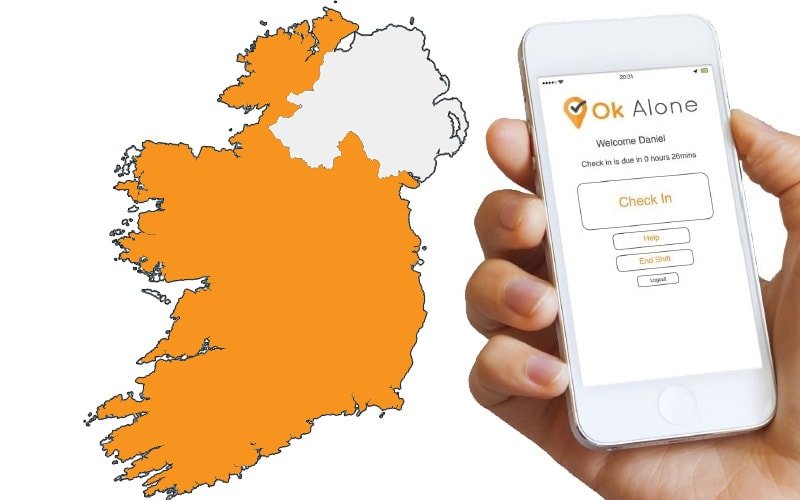Who are lone workers in Ireland?
The Health and Safety Authority of Ireland (HSA) identifies lone workers as ‘those who work by themselves without close or direct supervision. Anybody who works alone, including contractors, self-employed people and employee, is classed as a lone worker.’¹
Lone workers include:
- people in fixed establishments where only one person works on the premises, e.g. in small workshops, kiosks, petrol stations, shops and home-workers
- people working separately from others, e.g. in factories, warehouses, some research and training establishments, leisure centres or fairgrounds
- people who work outside normal hours, e.g. cleaners, security, special production, maintenance or repair staff, etc.
- people who work away from their fixed base, e.g. on construction, plant installation, maintenance and cleaning work, electrical repairs, lift repairs, painting and decorating, vehicle recovery, etc.
- agricultural and forestry workers
- service workers, e.g. rent collectors, postal staff, social workers, home helps, district nurses, pest control workers, drivers, engineers, architects, estate agents, sales representatives and similar professionals visiting domestic and commercial premises.
Section 19 of the Safety, Health and Welfare at Work Act 2005
Section 19 of the Safety, Health and Welfare at Work Act 2005 requires an employer to undertake a risk assessment and the outcome of that assessment shall determine whether or not an employee may work alone. Employers must also take into account any industry specific laws for lone working. Therefore, in general, an employer must assess whether an employee is at significantly higher risk when working alone and write that into their lone worker policy document.
Employer Responsibility for Lone Workers
Employers have responsibility for the health, safety and welfare of all their employees. They have responsibilities for the health and safety of those affected by work activities, for example visitors to any premises under their control and any self-employed or contract workers they engage.
What control measures should be in the lone working policy and implemented to minimise the risk to lone workers?
The risk assessment should prescribe control measures which will be implemented to eliminate/minimise the identified risks. Such control measures may include:
- communication with workers via mobile phone, telephone or radio
- controlled checks at regular, prearranged intervals
- panic alarms , no movement lone worker alarms, automatic distress message systems, i.e. pre-recorded message sent if not actively cancelled by operative, etc.
- instruction and training in proper procedures, e.g. code words for potentially violent situations when combined with mobile phone communication
- use of Personal Protective Equipment (PPE)
- health surveillance
- first-aid kits and training
- implementing Standard Operating Procedures (SOP’s)
- locking and securing place of work
- implementing correct incident reporting procedures
- provision of counselling
What does Irish Law say about Lone Working?
The Irish law S.I (Statutory Instruments) No. 467/1997 – Safety, Health and Welfare at Work (Extractive Industries) Reglulations, 1997 states that;
‘Workstations shall be designed and constructed according to ergonomic principles taking into account the need for employees to carry out operations safely and without risk to health at their workstations. Where workstations are occupied by lone employees, the necessary supervision or means of communication shall be provided.’
Communication is essential for lone worker protection. It is essential to have other people aware of a lone worker’s movements and to respond if a lone worker does not check in or follow their set schedule.
How will the lone worker be supervised?
Although lone workers cannot be subject to constant supervision, it is still an employer’s duty to adhere to their lone worker safety policy, and ensure their employee’s safety at work. Supervision can help to ensure that employees understand the risks associated with their work and that the necessary safety precautions are carried out. Supervisors can also provide guidance in situations of uncertainty. Supervision of health and safety regulations can often be carried out while following the legal requirement of periodic site visits, combined with discussions, in which health and safety issues are raised.
The extent of supervision required depends on the risks involved and the ability of the lone worker to identify and handle health and safety issues. Employees new to a job, undergoing training, doing a job which presents special risks, or dealing with new situations may need to be accompanied at first according to lone working regulations. The level of supervision required is a management decision, which should be based on the findings of risk assessment, i.e. the higher the risk, the greater the level of supervision required. To avoid legal issues it should not be left to individuals to decide whether they require assistance.
What provisions should be in place for lone workers in the case of an emergency?
- Lone workers should be capable of responding correctly to emergencies. Risk assessment should identify foreseeable events
- Emergency procedures should be established and employees trained in them
- Information about emergency procedures and danger areas should be given to lone workers who visit your premises
- Lone workers should have access to adequate first-aid facilities and mobile workers should carry a first-aid kit suitable for treating minor injuries
- Occasionally, the risk assessment may indicate that lone workers need training in first aid
Are there special factors to be considered for lone workers working at a remote location and/or in isolation?
For a lone worker at a remote location, the following factors must be considered:
- How long should the work take and how frequently should the worker report in?
- Has the worker a safe means of travel to and from the location, especially out of normal hours?
- Is there access to adequate rest, hygiene, refreshment, welfare and first aid facilities?
- Can emergency services approach the location without hindrance?
- Are there procedures for responding to a ‘worst-case scenario’?
Want to Try the Ok Alone App?
Ok Alone is a lone worker solution that uses a worker’s own smartphone to protect their health and safety. The lone worker app connects to a cloud-based dashboard that allows a supervisor to monitor the well being of their workers and get a precise GPS location if a worker is in distress.
1 – https://www.hsa.ie/eng/Topics/Hazards/Lone_Workers/#who

As an expert in lone worker content management, I possess an extensive knowledge base and experience in the area of lone working and safety monitoring. My expertise in this field encompasses a wide range of areas, including risk assessment, training, communication, and technology. I have a deep understanding of the unique risks associated with lone workers and have researched and written many projects and articles to educate people in how to mitigate these risks.
Throughout my time with Ok Alone, I have kept up to date with technological developments, legislative changes and regulations that have been introduced to help organizations ensure the safety of their lone workers.

